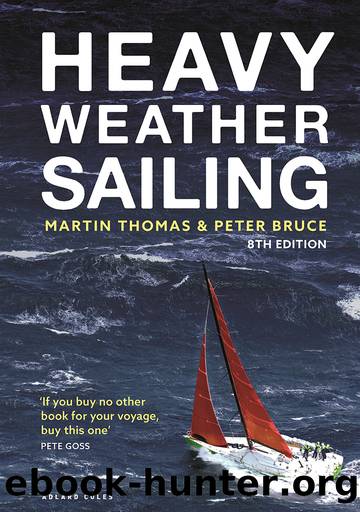Heavy Weather Sailing 8th Edition by Thomas Martin;Bruce Peter;

Author:Thomas, Martin;Bruce, Peter;
Language: eng
Format: epub
Publisher: Bloomsbury Publishing Plc
Published: 2022-08-15T00:00:00+00:00
Charm of Rhu in heavy weather, Dartmouth. PHOTO: MARTIN THOMAS
14
Storm tactics for sailing vessels
Susanne Huber-Curphey, Peter Bruce, Mark Orr and Martin Thomas
This chapter describes methods for coping in a severe storm. Susanne Huber-Curphey writes of the storms she has survived using drag devices. Peter Bruce brings his own huge experience, which includes winning his class in the infamous Fastnet Race of 1979. Mark Orr adds insights from his time sailing multihulls in rough seas. Additional material has been provided by Sir Robin Knox-Johnston, Steve Brown, Randall Reeves and other long distance yachtsmen.
There is a difference between âheavy weather sailingâ and âstorm survivalâ. In a sound and seaworthy boat, sailing in a gale can be an exhilarating experience. On the other hand, surviving storm conditions of force 10 and above is totally different. At this point, sailing is virtually impossible, the sea is angry and even the smallest sails might be too large. Expecting to manage tacking to windward is an impossible dream, holding position is difficult, while most sailing boats will drift to leeward. Usually this is no problem in open waters with sea room and anyway the destination might lie in the direction of the wind. I have seen the ocean, I know these conditions and in this chapter share my experience of 264,000nm at sea with over 2,000 nights afloat. I would say, âDo not be horrified by bad weather, nor be foolish in false optimism. Respect the elements and nature. Prepare the boat and try to exhibit good seamanship.â Sailing a boat in the hope that bad weather will not arrive or can be avoided is not an option.
All boats that cross oceans under sail will have to face impending rough weather sooner or later, weather that could well develop into a survival storm. A port offering shelter may be too far distant and to out-sail an approaching weather system is virtually impossible with the speed of most cruising yachts. As the barometer falls anxiety will rise. Be aware, this is not the time for experiment. Whichever storm tactic has been decided upon should be well prepared, planned in detail and ready.
Danger does not come from the force of the winds but from the tremendous power of the breaking waves they create. It is amazing how little time it can take for destructive breakers to build up in storm conditions. Just a few hours of howling winds can turn an exciting sea passage into a survival situation for boat and crew. A breaking wave with a height equal to half the boatâs length or even just its beam is likely to capsize the yacht. Every sailing boat behaves differently due to its size, keel shape, displacement or windage of the hull and rigging (roller furling makes quite a difference to windage). A sturdy 6.4m (21ft) boat could do just fine while a bigger boat might have to be abandoned. In general, larger yachts will get into trouble at a later stage, but in severe conditions every sailing boat can suffer a knockdown, roll through 360° or pitchpole over the bow.
Download
This site does not store any files on its server. We only index and link to content provided by other sites. Please contact the content providers to delete copyright contents if any and email us, we'll remove relevant links or contents immediately.
| 19th Century | 20th Century |
| Exploration | First Nations |
| Founding | Pre-Confederation |
| Province & Local | War of 1812 |
Cat's cradle by Kurt Vonnegut(14757)
Pimp by Iceberg Slim(13777)
Underground: A Human History of the Worlds Beneath Our Feet by Will Hunt(11836)
4 3 2 1: A Novel by Paul Auster(11788)
The Radium Girls by Kate Moore(11619)
Wiseguy by Nicholas Pileggi(5315)
American History Stories, Volume III (Yesterday's Classics) by Pratt Mara L(5133)
Perfect Rhythm by Jae(5070)
The Fire Next Time by James Baldwin(5016)
Paper Towns by Green John(4789)
Pale Blue Dot by Carl Sagan(4613)
A Higher Loyalty: Truth, Lies, and Leadership by James Comey(4550)
The Mayflower and the Pilgrims' New World by Nathaniel Philbrick(4277)
The Doomsday Machine by Daniel Ellsberg(4243)
Killers of the Flower Moon: The Osage Murders and the Birth of the FBI by David Grann(4188)
The Sympathizer by Viet Thanh Nguyen(4092)
Too Much and Not the Mood by Durga Chew-Bose(4089)
The Borden Murders by Sarah Miller(4013)
Sticky Fingers by Joe Hagan(3911)
